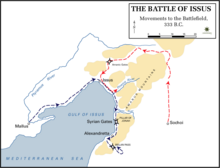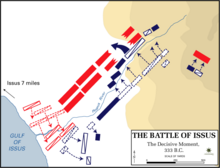Battle of Issus
36°50′16″N 36°12′40″E / 36.837894°N 36.211109°E
| Battle of Issus | |||||||||
|---|---|---|---|---|---|---|---|---|---|
| Part of the Wars of Alexander the Great | |||||||||
 Alexander battling Darius at the Battle of Issus (Naples National Archaeological Museum) | |||||||||
| |||||||||
| Belligerents | |||||||||
| Macedon, League of Corinth |
| ||||||||
| Commanders and leaders | |||||||||
|
Alexander the Great Parmenion Craterus, Hephaestion, Ptolemy, Pantordanus, Sitalces II Menes of Pella, Balacrus |
Darius III Arsames † Reomithres † Atizyes † Bubaces † Sabaces † | ||||||||
| Strength | |||||||||
|
40,850 in total: 13,000 peltasts,[1] 22,000 heavy infantry,[2] 5,850 cavalry[2] |
50-100,000 (modern sources) 250,000—600,000 (ancient sources) | ||||||||
| Casualties and losses | |||||||||
| 7,000[3] | ~20,000 | ||||||||
The Battle of Issus occurred in southern Anatolia, in November 333 BC between the Hellenic League led by Alexander the Great and the Achaemenid Persia, led by Darius III, in the second great battle of Alexander's conquest of Asia. The invading Macedonian troops defeated Persia. After the Hellenic League soundly defeated the Persian satraps of Asia Minor (led by the Greek mercenary, Memnon of Rhodes) at the Battle of the Granicus, Darius took personal command of his army. He gathered reinforcements and led his men in a surprise march behind the Hellenic advance to cut their line of supply. This forced Alexander to countermarch, setting the stage for the battle near the mouth of the Pinarus River and the town of Issus.

Location
The battle took place south of the ancient town Issus, which is close to present-day Turkish town of Iskenderun (the Turkish equivalent of "Alexandria", founded by Alexander to commemorate his victory), on either side of a small river called Pinarus. At that location, the distance from the Gulf of Issus to the surrounding mountains is only 2.6 km (2 mi), a place where Darius could not take advantage of his superiority in numbers. Speculation on the location of the Pinarus has taken place for over 80 years. Older historians believed it to be the Deli Tchai river, but historians N.G.L. Hammond and A.M. Devine have made convincing claims that the Pinarus is actually the Payas River, the latter using eye-witness examination of the river, which may not have drastically changed since antiquity. Their evidence is based on Callisthenes' accounts of the measurements of the battlefield and distances marched by both side's armies in the prelude to the battle and distance given by Diodorus after the battle.
Background

Alexander set out into Asia in 334 BC and defeated the local Persian satraps at the Battle of the Granicus. He then proceeded to occupy all of Asia Minor, with the idea of capturing all coastal settlements so as to negate the power of the vastly superior Persian fleet. He captured several important settlements such as Miletus in 334 BC and Halicarnassus, a siege lasting four months, starting in late December the same year. While Alexander was in Tarsus, he heard of Darius massing a great army in Babylon. If Darius were to reach the Gulf of Issus, he could use the support from the Persian fleet under Pharnabazus still operating in the Mediterranean Sea, thus easing his supply and possibly landing troops behind the enemy. Alexander kept his main army at Tarsus but sent Parmenion ahead to occupy the coast around Issus. In November, Alexander received reports that the great Persian army had advanced into Syria to a town named Sochi. Alexander decided to mass his scattered army and advance south from Issus through the Pass of Jonah.
Darius knew that Parmenion held the Pass of Jonah and thus chose a northern route of advance. The Persians captured Issus without opposition and cut off the hands of all the sick and wounded that Alexander had left behind. Now Darius found out he had placed his army behind the Hellenic League and had cut their supply lines. He then advanced to the south and got no further than the river Pinarus before his scouts spotted Alexander marching north. Darius had to set up camp on this narrow coastal plain.
Motives

There is much debate as to the motives of Alexander and Darius preceding Issus. A strong and convincing modern perspective, based on Curtius, is that Darius was forced to move camp to terrain that favored Alexander because Alexander was fighting defensively due to a recommendation by his war council and Parmenion. Darius' large army could not be supported in the field during winter and his cities in Phoenicia were already in unrest at the arrival of Alexander. Darius was forced to move his large army to a small battlefield, greatly to the advantage of Alexander's smaller force.
Alexander was waiting for Darius to come south around the Amanus Mountain range because the pass Darius would have used, the Belen Pass, was much closer to Sochi and offered the quickest access to the area Alexander defended. Alexander was waiting 15 km (9.3 mi) to the west of the Belen Pass at Myriandrus to spring a trap on Darius as he crossed through the Belen Pass or through the Pillar of Jonah if he moved north, where Darius' army would be disorganized and disjointed in the narrow crossing. Darius instead moved north from Sochi and around the mountains, emerging behind Alexander's position and on his supply and communication lines. Thus Alexander was forced to march to Darius, who had caught him off guard in a large flanking maneuver. This gives the illusion that Darius was the one acting defensively, since Alexander was forced to march to him.
Combatants
Persian army
Some ancient sources (Arrian and Plutarch), who based their accounts on earlier Greek sources, estimated 600,000[2] Persian soldiers in total, while Diodorus and Justin estimated 400,000, and Curtius Rufus estimated 250,000.
Modern historians find Arrian's count of six hundred thousand men highly unlikely. They argue that the logistics of fielding more than 100,000 soldiers in battle was extremely difficult at the time. Hans Delbrück gives an estimate as small as 25,000, although most (including Engels and Green) estimate the total size of Darius' army to be no larger than 100,000 at Issus,[4] including 11,000 cavalry,[2] 10,000 Persian Immortals, and 10,000 Greek mercenaries.[5] Warry estimates 108,000 in total.
Macedonian army
The size of the Hellenic army may not have exceeded 40,000 men, including their other allies, led by Alexander. Alexander's army may have consisted of about 22,000 phalangites and hoplites, 13,000 peltasts, and 5,850 cavalry.[2]
Battle
The Greeks advanced through the Pillar of Jonah. Alexander led his Companion cavalry on the right flank and he set his Thessalian allied cavalry on the left of the phalanx with Parmenion in command.
Darius formed his line with his heavy cavalry concentrated next to the coast on his right, followed by the Greek mercenary phalanx (historian A.M Devine places them at a strength of 12,000, comparable to Alexander's Greek phalanx). Next to the Greek phalanx Darius spread his Persian infantry, the Cardaces, along the river and into the foothills, where they wrapped around to the other bank and threatened Alexander's right flank (the formation resembled gamma, Γ). Arrian gives an inflated figure of 20,000 to these troops. Darius positioned himself in the centre with his best infantry, the Greek mercenaries, and his royal cavalry guard. According to some historians, like P. Stratikis, he was trying to replicate the Hellenic battle formation of the Battle of the Granicus.

The Persian cavalry first charged Parmenion and the allied cavalry, crossing the river to open battle. Alexander's left wing became the crux of the battle, as at Gaugamela two years later, where Parmenion held the wing long enough against superior Persian numbers for Alexander to make his calculated cavalry strike against Darius and break the Persian army. The Hypaspists led by Alexander, on foot, delivered an assault during this time across the riverbed on the Cardaces and managed to punch a hole through the Persian line.
Alexander then mounted a horse at the head of his Companion cavalry and led a direct assault against Darius who fled from the battlefield. Alexander then saw his left flank and center in trouble, let Darius flee, and crashed into the rear of the Greek mercenaries. The Greek mercenaries broke up. The Persians saw that their Great King had gone and that the battle was being lost, and they abandoned their positions and fled in full rout. The Hellenic cavalry pursued the fleeing Persians for as long as there was light. As with most ancient battles, significant carnage occurred after the battle as pursuing Greeks slaughtered their crowded, disorganized foe. Arrian notes that Ptolemy I mentions that, while pursuing Darius, Alexander and his bodyguards came upon a gap which they easily crossed on the bodies of dead Persians. It was a decisive victory for Alexander.
Aftermath

The Battle of Issus was a decisive Hellenic victory and it marked the beginning of the end of Persian power. It was the first time the Persian army had been defeated with the King (Darius III at the time) present. After the battle, the Hellenes captured Darius' wife, Stateira I, his daughters, Stateira II and Drypetis, and his mother, Sisygambis; all of whom had accompanied Darius on his campaign. Alexander, who later married Stateira II, treated the captured women with great respect.
Depictions of the battle

- German Renaissance painter and printmaker Albrecht Altdorfer (c. 1480-1538) dramatically depicted the battle in his 1529 painting The Battle of Alexander at Issus.
- The Battle of Issus (ca. 1599–1600) by Jan Brueghel the Elder (1568–1625) hangs in the Louvre.
- American Abstract Expressionist painter Cy Twombly diagrammed the battle in his 1968 painting Synopsis of a Battle.[6]
- The 2004 Oliver Stone film Alexander was expected to depict the battle, instead, it put elements of the Battle of the Granicus, Issus, and Gaugamela all together. It was labeled as the Battle of Gaugamela but held distinctive elements of all three battles. The Battle of the Hydaspes River was also featured.
- Contemporary fine-artist Rossi d'Providence has created an oil painting of the Battle at Issus for the Classics Department at Brown University in Providence, Rhode Island.[7]
References
- ^ Warry (1998) estimates Alexander's army to be 31,000 in total.[page needed]
- ^ a b c d e Moerbeek (1997).[page needed]
- ^ Welman estimates over 16% of the Hellenic army were killed.[page needed]
- ^ Battle of Issus (Pothos.org)
- ^ Welman.
- ^ http://www.vmfa.state.va.us/Collections/Mid_to_Late_20th-Century_Art/Twombly_85_451.aspx
- ^ Battle of Issus View the 275 cm x 120 cm (9 foot by 4 foot) painting
Sources
Ancient
- Diodorus Siculus (90-30 BC). Bibliotheca Historica.
- Quintus Curtius Rufus (AD 60-70). Historiae Alexandri Magni.
- Plutarch (AD 75). The Life of Alexander the Great, Parallel Lives.
- Arrian (AD 86-146). Anabasis Alexandri.
- Junianus Justinus (3rd century). Historiarum Philippicarum libri XLIV.
Modern
- Delbrück, Hans (1920). History of the Art of War. University of Nebraska Press. Reprint edition, 1990. Translated by Walter, J. Renfroe. 4 Volumes.
- Engels, Donald W. (1978). Alexander the Great and the Logistics of the Macedonian Army. Berkeley/Los Angeles/London.
- Fuller, John F. C. (1960). The Generalship of Alexander the Great. New Jersey: De Capo Press.
- Green, Peter (1974). Alexander of Macedon: A Historical Biography.
- Moerbeek, Martijn (1997). The battle of Issus, 333 BC. Universiteit Twente.
- Rogers, Guy (2004). Alexander: The Ambiguity of Greatness. New York: Random House.
- Warry, J. (1998), Warfare in the Classical World. ISBN 1-84065-004-4.
- Welman, Nick. Army. Fontys University.
